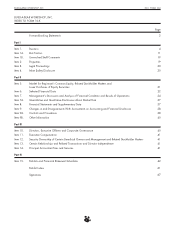Build-A-Bear Workshop 2011 Annual Report Download - page 20
Download and view the complete annual report
Please find page 20 of the 2011 Build-A-Bear Workshop annual report below. You can navigate through the pages in the report by either clicking on the pages listed below, or by using the keyword search tool below to find specific information within the annual report.
BUILD-A-BEAR WORKSHOP, INC. 2011 FORM 10-K
co-tenants, the availability or cost of appropriate locations
within existing or new shopping malls or the desirability,
safety or success of shopping malls. In addition, customer mall
traffic may be reduced due to a loss of consumer confidence
because of the economy, terrorism or war. If we are unable to
generate sufficient guest traffic, our sales and results of
operations will be harmed. A significant decrease in shopping
mall traffic could have a material adverse effect on our
financial condition and profitability. For example, we have
experienced a decline in transactions at comparable locations
over the past several years.
If we are unable to generate interest in and demand for our
interactive retail experience, including being able to identify
and respond to consumer preferences in a timely manner,
our financial condition and profitability could be
adversely affected.
We believe that our success depends in large part upon our
ability to continue to attract guests with our interactive
shopping experience and our ability to anticipate, gauge and
respond in a timely manner to changing consumer
preferences and fashion trends. We cannot assure you that
our past success will be sustained or there will continue to be
a demand for our “make-your-own stuffed animal” interactive
experience, or for our stuffed animals, animal apparel and
accessories. A decline in demand for our interactive shopping
experience, our animals, animal apparel or accessories, or a
misjudgment of consumer preferences or fashion trends, could
have a negative impact on our business, financial condition
and results of operations. For example, in 2008 we
announced plans to close the Friends 2B Made concept. The
closure was completed by the end of the fiscal 2009 third
quarter with pre-tax charges totaling $3.9 million. In addition,
if we miscalculate the market for our merchandise or the
purchasing preferences of our guests, we may be required to
sell a significant amount of our inventory at discounted prices
or even below costs, thereby adversely affecting our financial
condition and profitability. For example, in 2007, we
wrote-off $1.6 million, net of tax, of inventory, including
excess Shrek®merchandise.
Our future growth and profitability could be adversely
affected if our marketing and online initiatives are not
effective in generating sufficient levels of brand awareness
and guest traffic.
We continue to update and evaluate our marketing initiatives,
focusing on brand awareness, new product news, timely
promotions and rapidly changing consumer preferences. We
may not be able to successfully engage children in our virtual
world website, bearville.com, and achieve high enough traffic
levels nor be able to leverage the site to drive traffic to our
stores. Our future growth and profitability will depend in large
part upon the effectiveness and efficiency of our marketing
programs and future marketing efforts that we undertake,
including our ability to:
• create greater awareness of our brand, interactive
shopping experience and products;
• identify the most effective and efficient level of spending
in each market;
• determine the appropriate creative message and media
mix for marketing expenditures;
• effectively manage marketing costs (including creative
and media) in order to maintain acceptable operating
margins and return on marketing investment;
• select the right geographic areas in which to market;
• convert consumer awareness into actual store visits and
product purchases; and
• reach a level of engagement on the virtual world Web
site with large numbers of unique visitors with frequent
visitation that drives visits to our retail stores resulting
in purchases.
Our planned marketing expenditures may not result in
increased total or comparable store sales or generate
sufficient levels of product and brand awareness. We may not
be able to manage our marketing expenditures on a cost-
effective basis.
If we are unable to increase our comparable store sales
trends, our results of operations and financial condition could
be adversely affected.
Our comparable store sales for 2011 declined 2.1%
following a 2.0% decline in 2010, a 13.4% decline in fiscal
2009, a 14.0% decline in fiscal 2008 and a 9.9% decline in
fiscal 2007. We believe that the decrease in 2011 was
primarily attributable to the underperformance of certain
licensed movie products in the fourth quarter. We believe that
global economic conditions continued to impact our
comparable store sales in 2010. We believe that the
decrease in fiscal 2009 was primarily attributable to the
continued economic recession and dramatic decrease in
consumer sentiment and the decline in North American
shopping mall traffic. We believe that the decrease in 2008
was primarily attributable to the economic recession and
decrease in consumer disposable income, a continued decline
in shopping mall customer traffic and changes in media
strategies, online entertainment, children’s media consumption
and play patterns. We believe that the decrease in 2007 was
primarily attributable to a decline in shopping mall customer
traffic and consumer spending on discretionary products,
changes in media strategies, online entertainment, children’s
media consumption and play patterns, competitive plush
animal products and lower than expected customer purchases
of select licensed movie products introduced in the fiscal
12
























